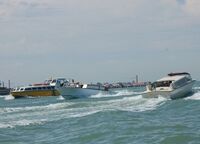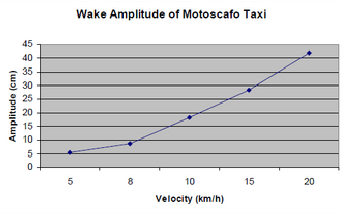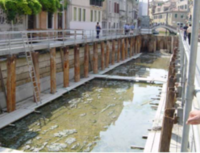Moto Ondoso
The moto ondoso, or wave movement, is a major environmental problem both in Venice and in the lagoon. After World War II, a huge technological boom replaced the traditional rowboats by motorboats as a faster and more efficient means of transportation for people, goods, and garbage in the Venetian canals. Venetian canals and buildings are significantly affected by the continuous massive wake force produced by the boats, experiencing destabilization as the canal walls deteriorate over time. As boats moves through the canals, turbulenceis created, which is an unstable eddying motion in the water caused by the spinning propellers. The wake and the turbulence mingle to erode the canal walls. Thus, moto ondoso is the primary example of negative impacts of boat traffic in Venice. While most cities in the modern world have primary concerns of traffic impacts resulting from pollution, moto ondoso imposes a demanding and immediate threat that has the potential to compromise areas of the city's structural integrity if left ignored and untreated.

| Please help improve this article by expanding it. |
Moto Ondoso in Venice
Hydrodynamics of Moto Ondoso
As mentioned above, the boat propellers that cause turbulence in the water are the basic cause for boat wakes. Many factors determine the size of the wake such as the speed of the boat, the size of the boat’s propeller, the power of the boat engine, the size of the canal being traversed, and the boat’s load. It’s difficult to link a specific wake size to a specific speed, but a relative scale divided into 3 categories can be useful.

- Displacement speed: This is the minimal boat speed; minimal wake is created at this stage.
- Transition speed: This occurs when the boat is accelerating, highest amount of wakes are created at this stage.
- Planning speed: This occurs after the transition speed, the wakes created at this speed are fewer than the wakes at the transition speed but more than the wakes in the displacement speed.
Aggravating Moto Ondoso
Certain factors can cause greater amounts of boat wakes and force against the canal walls
Moto ondoso and Boat Speed
A study undertaken by WPI students shows that the small cargo boats travel the fastest in the lagoon that surrounds Venice with an average speed of 13.5 Km/h, causing the highest boat wakes, followed closely by service and personal boats with speeds of 12.1 Km/h and 12.7 Km/h respectively. The boat type with the slowest average speed is the Vaporetto which travels at an average of 8.9 Km/h. The image below and to the right shows what percentages of boats are traveling at different speeds. Disregard for the speed limits by the cargo and taxi boats in the canals causes the largest wakes and play the biggest part in damaging the canal walls.

Effects on Canal Wall Damage
The deterioration of the canal walls occurs when their physical and mechanical conditions are altered. The turbulence in the water caused by boat wake is a major factor in the destruction of the canal walls because it persistently erodes the wall material or the mortar that acts as a seal between the bricks and stones. When the mortar erodes, the bricks and stone become disjointed and are thus much more susceptible to the destructive stresses and forces of boat wakes. Imperfections in the wall surface, such as missing or chipped bricks, make the canal walls more vulnerable to erosion. When turbulence in the water comes into contact with a flat wall, it can only affect the surface area. Holes and uneven brick increase the surface area of the wall, allowing water to do more erosive work. Water will flow into the hole and instead of being reflected off, it will swirl around inside the hole. Occasionally, a wall will appear to be almost flawless, but due to a hole or missing brick water has been entering and eroding the wall behind the surface.
Restoration Methods
The Venetian company Insula is the company currently contracted to restore these damaged canal walls. The following are the methods of restoration currently in use:
- Wooden piles are driven into the bottom along the outer edge of the foundation to support a kerb, or continuous metal sheet piling (approx. 2.5 m deep). They are embedded along the outer edge of the foundation to prevent undermining and water stench, reforming the "scarp" (shoe) at the foot of the foundation.
- Mortar joints are restored by making injections made to reinforce the surface. Walls are resealed by a technique known as "binder sealing", in order to reconstruct the missing part of the outer face, thus restoring the body of the wall to its former compactness and physical continuity.
- Corrective action, construction, or partial rebuilding, is performed in order to compensate for any swelling that alters alignment or shifts the original geometry.

Moto Ondoso Demo
For a visual representation of moto ondoso, see these videos:
References
- Commune di Venezia: Assessorato ai Trasporti e servizi Pubblici Commissione per lo studio del moto ondoso, May 1994.
- Carrera, Fabio and Caniato, Giovanni; “Venezia la Citta Dei Rii”
- Pax in Aqua: http://www.provincia.venezia.it/paxinaqua/home.html June 2002
- Insula: http://www.insula.it